Pregnant pygmies
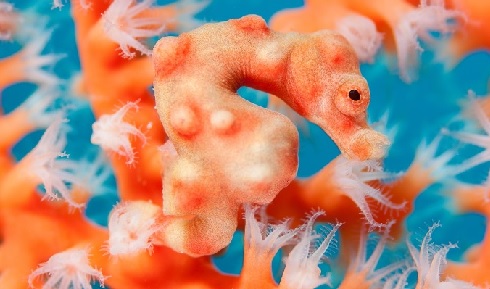
Dr Richard Smith introduces an exclusive extract from his new collection of marine biology research, photography and tales of discovery, The World Beneath, which includes the first images ever taken of a male pygmy seahorse giving birth
December 4th 2020
A sum of many experiences came together to put me 15 metres below the water’s surface on a tropical coral reef, recording the first observations of the elaborate social lives of the world’s smallest seahorses. A Durrellian childhood, learning to dive at the age of 16 and later picking up a camera to help identify tiny 3mm sea slugs certainly pointed me in the right direction.
The following excerpt shares some of the fascinating behavioural observations I recorded from one group of pygmy seahorses that I studied during my PhD. The biology of these fishes had not been studied before, probably due to their recent discovery, their habitat specificity and the fact that the largest species barely stretch across a two pence coin. Spending so much time on coral reefs observing life at this miniature scale really trained my brain to notice other species or subtle behaviours that had previously been overlooked.
 A heavily pregnant male Denise’s pygmy seahorse (Hippocampus denise). Pictures courtesy of Dr Richard Smith
A heavily pregnant male Denise’s pygmy seahorse (Hippocampus denise). Pictures courtesy of Dr Richard SmithWhether capturing the moment an anemonefish yawns to reveal a pair of sinister tongue-biter isopod parasites in its throat, or photographing the frantic but colourful displays of a never-before-seen flasher wrasse on the reefs of Indonesia, there is always something new to discover on a dive. Over the past couple of years I’ve been involved in naming the two most recently described pygmy seahorse species – one from Japan and one from South Africa, the latter being the first of its kind in the Indian Ocean. The oceans continue to surprise us and we have much to learn, particularly at this smaller scale.
Extract from The World Beneath by Dr Richard Smith
In southern Australia, around the jetties of the Mornington Peninsula outside Melbourne, two seahorse species can be found. The potbellied seahorse is the world’s largest, at a foot in length, while the short-head seahorse measures under 10cm. Despite their divergent sizes, they are sister species, each other’s closest relatives.
This propensity toward dwarf forms appears to have developed through the seahorse’s preference for a mate of around the same size. Smaller males tend to mate with smaller females and the same goes for larger partners. Selecting a mate of a similar size allows both parties to raise as many young as possible: if a large male mated with a small female, there would be wasted space in his pouch. In reverse, if a small male mated with a large female, there would be insufficient space in his pouch to accommodate her full clutch of eggs and some would go to waste. Over time, the preferential mating of smaller seahorses with other smaller seahorses has pushed their sizes to extreme limits and resulted in the formation of very small species.
In 1969 a new and unique seahorse was discovered by accident when a diver, Georges Bargibant, was collecting a gorgonian coral for the Nouméa Aquarium in New Caledonia. Gorgonian corals are the coral reef’s equivalent of oak trees: they provide habitat for many animals and may live for over a hundred years. Generally flat, bright red, pink or yellow in colour and often about half the size of a table tennis table, gorgonians comprise a massive colony of polyps that open at certain times of day to filter feed particles from the water.
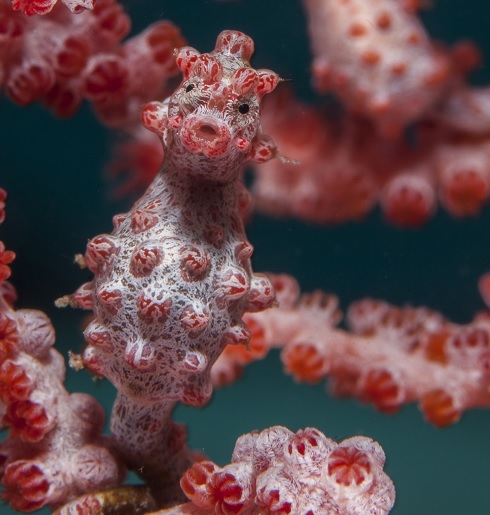 Bargibant’s pygmy seahorses (Hippocampus bargibanti) were discovered accidentally in 1969 by a researcher collecting gorgonian corals for a museum. Pictures courtesy of Dr Richard Smith
Bargibant’s pygmy seahorses (Hippocampus bargibanti) were discovered accidentally in 1969 by a researcher collecting gorgonian corals for a museum. Pictures courtesy of Dr Richard SmithAs Bargibant spent some time underwater with the gorgonian he had collected, he suddenly spotted two odd little creatures clinging to its surface. He had discovered the first-known pygmy seahorses. A year later the tiny seahorse, measuring just one inch long, was named in his honour as Hippocampus bargibanti. The large numbers of divers and budding underwater naturalists who have started to explore shallow tropical reefs over the past 20 years have generated a flurry of new pygmy seahorse discoveries since the beginning of the 21st century.
True pygmy seahorses have several morphological adaptations for their small size that distinguish them from other seahorses. They have a single gill opening behind the head rather than paired openings, and they brood their young within the trunk rather than in a pouch on the tail. Dwarf seahorses, on the other hand, are identical to the larger species in every way except their size.
Birth story
Using as little light as I am able to in order to watch the events unfolding before me, I see the rotund pregnant male pygmy seahorse risk his life by releasing his vice-like grasp on the gorgonian to fight the current and swim to where it strikes. There, he reattaches to the gorgonian, and, once he is confident that he has a strong hold, he begins to go into labour. Just moments before, after a 10-minute swim against the current along the dark and gloomy reef wall, I had arrived at the gorgonian home of my pygmies. I immediately began to seek out each one of the four residents, which I could identify individually by colour and size, before beginning observations that I scribbled on A4 waterproof paper.
Early on in my research peer pressure from my dive guide friends had morphed my rigid scientific-minded nomenclature of the four fish from 1, 2, 3 and 4 to Tom, Dick, Harry and Josephine. This unusual conjugal situation – Josephine and three males – gave me a unique opportunity to observe whether the fabled seahorse monogamy could endure such temptation.
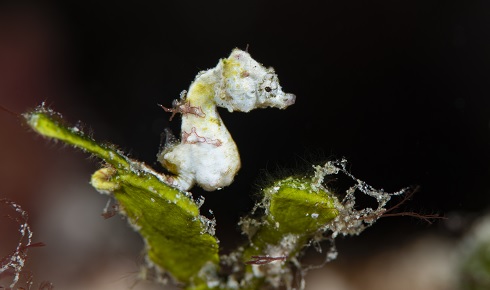 Pontoh’s pygmy seahorse (Hippocampus pontohi) is one of the smallest pygmy seahorses, measuring less than 2cm from the tip of the snout to the tail. Pictures courtesy of Dr Richard Smith
Pontoh’s pygmy seahorse (Hippocampus pontohi) is one of the smallest pygmy seahorses, measuring less than 2cm from the tip of the snout to the tail. Pictures courtesy of Dr Richard SmithThe gorgonian buzzed with activity soon after my arrival. Tom, with a belly swollen like a miniature basketball, swam out from the little nook he shared with his gorgonian mates, to an exposed edge of the expanse. Without much ado he bent over, expelling numerous tiny black specks into the ocean. These specks, of course, were the brood of young that he had been nurturing in his pouch for the past two weeks. Another couple of contractions and the baby seahorses were released into the water. Before being carried off in the current, the babies uncurled to reveal their heritage; they resembled darkened, miniature versions of their parents.
After the birth the newborn seahorses set off on their own and would never see their parents again, instead spending a couple of weeks at the whim of ocean currents before finding a gorgonian of their own on which to settle. My research showed that after they found a suitable gorgonian they need only five days to change their dark free-floating coloration to match their new gorgonian home in colour and surface texture.
Tom was visibly drained after the birth. His previously rotund physique heaved with stress and exhaustion – now he was surely the only male in the animal kingdom with stretch marks. This would be the only moment of rest for Tom; his day had just begun. No sooner had he given birth than he headed back to the little nook where the other three rested. Josephine immediately noticed his return and the two began an age-old ritual of mirrored movements.
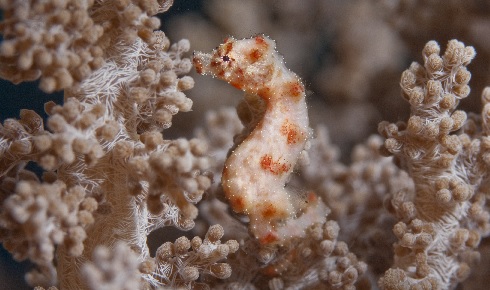 Walea soft coral pygmy seahorses (Hippocampus waleananus) live only in association with shallow-water soft corals in the Tomini Gulf of central Sulawesi, Indonesia. Pictures courtesy of Dr Richard Smith
Walea soft coral pygmy seahorses (Hippocampus waleananus) live only in association with shallow-water soft corals in the Tomini Gulf of central Sulawesi, Indonesia. Pictures courtesy of Dr Richard SmithAfter conveying to Josephine that he had given birth and was receptive to mating, the pair slowly loosened their grip of the gorgonian and hovered above it. They intertwined their tails, holding together their tiny genital openings. Josephine’s belly, swollen with eggs, gradually shrank as she pushed the clutch of unfertilised eggs into Tom’s pouch. His deflated and wrinkled belly became correspondingly plumper as the eggs entered his pouch and he fertilised them, ensuring him certainty over his fatherhood. The pair’s reproductive synchrony, ensured by daily courtship dances, allowed Tom and Josephine to re-mate so soon. Forty-five seconds later the pair went their separate ways; Tom, presumably, needing a rest.
Bargibant battles
During my research I discovered a terrible truth: not all seahorses are the portraits of domestic bliss that we assumed. I regularly found the three males, Tom, Dick and Harry, involved in brawls. Seahorse brawling is a surprisingly comedic affair that involves their most prized appendage: the tail. In one skirmish, Dick grasped Tom around the base of his tail and shoved him off the gorgonian.
Harry seized the opportunity and grasped Dick around the neck with his tail too. Since both the bigger males were being held, neither wanted to lose face and let go. The tussle lasted a good several minutes and Tom was left with a sprained tail.
Behind these brawls, of course: Josephine, who was mating with both Tom and Dick. With a gestation period of 12 days, Josephine would mate with one of the males after he gave birth, and then mate with the other six days later, while the first male was only halfway through his pregnancy. Both males were always pregnant and Josephine was constantly hydrating eggs for them. She conducted twice daily dances with both males to keep tabs on their due dates. This is the first time a seahorse has been found to engage in polygamy.
In fact, in this case since it was the female mating with two males, it is technically known as ‘polyandry’. Poor Harry never did get a second look during my study, being much smaller than the other two males and presumably failing to gain traction in the wrestling matches.
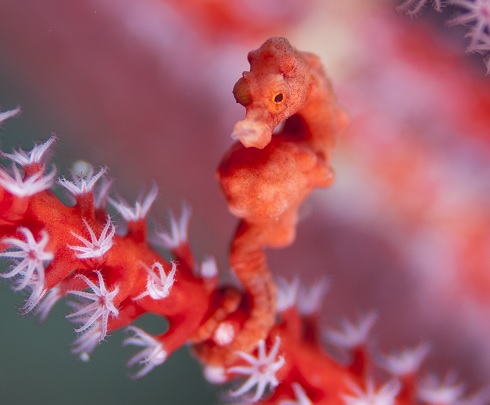 Pygmy seahorses mimic the appearance and texture of their gorgonian coral homes. Pictures courtesy of Dr Richard Smith
Pygmy seahorses mimic the appearance and texture of their gorgonian coral homes. Pictures courtesy of Dr Richard SmithMénage à trois
My research required that I next turn my attention to a female-biased ménage à trois – I was intrigued to find out whether a single male would accept eggs from two females. Luckily, at my study site there was no shortage of pygmies and I soon found a perfect group: Brad, Jennifer and Angelina.
I spent many hours with the trio, observing and recording their every interaction. I found that Brad and Jennifer shared a core area on one side of the gorgonian while Angelina slept on the other. A core area is the protected area of the gorgonian where they carried out their social bonding dances, mated and slept. Tom, Dick, Harry and Josephine all slept together in one small core area.
During my research Brad and Jennifer raised several broods together, but all the while Brad was also flirting with Angelina. Each morning, after bonding dances with Jennifer, Brad would leave their core area and swim to the other side of the gorgonian where Angelina bided her time. Angelina and Brad then carried out the same social bonding dances, but they never mated. In the world of pygmy seahorses, it is always best to keep your options open in case something were to happen to a partner. Unlike the pugnacious males, the two females eschewed violence, instead electing cool indifference.
Group dynamics
Broadening my search further, I found another group of pygmies along the reef. On a bright red gorgonian, three pairs shared a home. This offered the opportunity to investigate how bonded pairs interacted with each other. Would jealousy feature in a male pygmy seahorse’s behaviour when he was happily partnered? Mapping home ranges and recording social interactions led me to conclude that it would not.
 The Japanese pygmy seahorse (Hippocampus japapigu) was described by the author and colleagues in 2018. Pictures courtesy of Dr Richard Smith
The Japanese pygmy seahorse (Hippocampus japapigu) was described by the author and colleagues in 2018. Pictures courtesy of Dr Richard SmithOn a gorgonian as big as a 34in television screen these individuals spent their entire lives confined to an area as small in some cases as three adjoining Post-it Notes, while the largest spanned the area of a double-page spread in a magazine. Males generally used less space than females, which is probably due to the difficulty of travelling when inflated with young.
When happily settled with a single partner males appeared to pay no attention to other males even though their home ranges often overlapped. Hunting for prey to fuel their constant egg production and pregnancy is a full-time pursuit, so they searched for and grazed on the miniscule crustaceans that live on the surface of the gorgonian. After studying the pygmies’ private lives in depth, I embarked on a mission to discover more about their general biology.
The World Beneath: The Life and Times of Unknown Sea Creatures is published by Apollo
The first pygmy seahorse to be discovered was Hippocampus bargibanti, or Bargibant’s pygmy seahorse, in 1969. In 2003 Denise’s pygmy seahorse was discovered and found to live on several types of gorgonian coral, not just the one species H. bargibanti is specialised to live on. They vary in colour and texture depending on the specific coral they inhabit. Coleman’s pygmy seahorse was discovered in 2003 and in 2008 Pontoh’s, Satomi’s and Severn’s pygmy seahorses were added to the list. These four species tend to have more varied habitats, including algal tufts and filamented reef invertebrates, making them particularly difficult to find.
Dr Richard Smith is an award-winning underwater photographer, author and marine conservationist. A marine biologist by training, he is a member of the IUCN Seahorse, Pipefish and Seadragon Specialist Group. He has named the two most recent pygmy seahorse discoveries from Japan (Hippocampus japapigu) and South Africa (Hippocampus nalu).
• Instagram @Dr.RichardSmith
• Facebook @OceanRealmImages
• Twitter @Rich_Underwater


